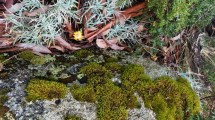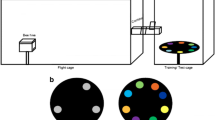Abstract
DIFFERENTIAL reactions to various wave-lengths or wave-length bands, independent of intensity, have been claimed for several members of the group of Diptera1–4. None of the authors concerned, however, had based his experiments on the training method which, when applied to honey-bees, had yielded more detailed and exhaustive results than any other method5,6. It may therefore be of interest that a solitary insect belonging to the group of Diptera has been trained to colours successfully for the first time, in preliminary experiments carried out in this Department.
Similar content being viewed by others
References
Hamilton, W. F., Proc. U.S. Nat. Acad. Sci., 18 (1922).
van Herk, A. W., Arch, neerl. Physiol., 10 (1926).
Knoll, F., Abh. zool.-bot. Ges. Wien, 12 (1922).
Schlegtendal, A., Z. vergl. Physiol., 20 (1933–34).
v. Frisch, K., Zool. Jahr. Abt. Allg. Zool. u. Physiol., 35 (1914).
Kuehn, A., Z. vergl. Physiol., 5 (1927).
Ilse, D., Z. vergl. Physiol., 8 (1928).
Author information
Authors and Affiliations
Rights and permissions
About this article
Cite this article
ILSE, D. Colour Discrimination in the Dronefly, Eristalis tenax. Nature 163, 255–256 (1949). https://doi.org/10.1038/163255a0
Issue Date:
DOI: https://doi.org/10.1038/163255a0
- Springer Nature Limited
This article is cited by
-
Spontaneous colour preferences and colour learning in the fruit-feeding butterfly, Mycalesis mineus
Behavioral Ecology and Sociobiology (2019)
-
Visual ecology of flies with particular reference to colour vision and colour preferences
Journal of Comparative Physiology A (2014)
-
Bumblebees (Bombus terrestris) and honeybees (Apis mellifera) prefer similar colours of higher spectral purity over trained colours
Journal of Comparative Physiology A (2013)
-
Unidirectionality of floral colour changes
Plant Systematics and Evolution (1996)
-
Interspecific diversity and uniformity of flower colour patterns as cues for learned discrimination and innate detection of flowers
Experientia (1993)





